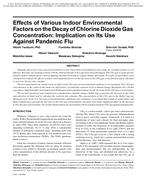Description
Pandemic flu is now a big concern all round the world. Prevention of the influenza virus using Air cleaning systems is very effective. Recently, air cleaning systems with the chlorine dioxide (ClO2) gas have been developed. The ClO2 gas is easily decomposed by indoor climate factors such as lighting, thermal environment, organic matter, and sound. Two types of experiments were conducted to evaluate the effects of indoor environmental factors on the decrease in the ClO2 gas concentration and to calculate its reaction (decay) rate constant.
The first experiment was conducted in an office room. Ten types of environmental conditions were examined. The ClO2 gas concentration at the centre of the room was kept below a permissible exposure level to human beings throughout the 120-min experiment. High-humidity environment and illuminance had a significant impact on the decrease in the ClO2 gas concentration. The second experiment was conducted in a thermostatic chamber using a Tedlar bag to measure the decrease in the ClO2 concentration in detail and to calculate the reaction rate constant. The concentration of the ClO2 gas in the Tedlar bag was measured every 1h for 6 h. Ten types of environmental conditions were examined. It was found that a high air temperature and light irradiation accelerated the decrease in the ClO2 gas concentration; the latter had a more significant effect on the decrease in the ClO2 gas concentration. The results obtained from our experiments will be useful in using the ClO2 gas against pandemic flu.
Citation: IAQ Conference: IAQ 2010: Airborne Infection Control
Product Details
- Published:
- 2011
- Number of Pages:
- 10
- File Size:
- 1 file , 1.1 MB
- Product Code(s):
- D-IAQ2010-C166-10




